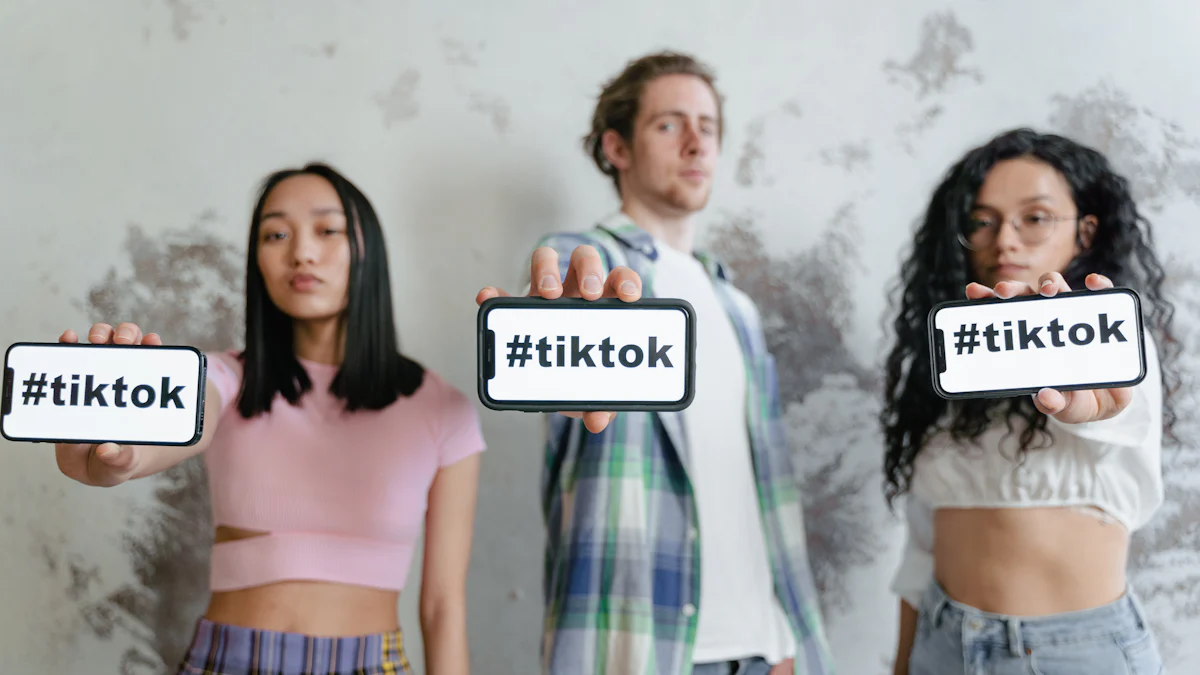Proven Tips for Small Businesses to Start Influencer Marketing

Influencer marketing for small business has become a game-changer for companies like yours. Why? It helps you connect with your audience in a way that feels personal and authentic. Did you know 70% of people trust influencers more than celebrities? Plus, working with nano or micro-influencers often leads to higher engagement rates. Compared to traditional advertising, influencer marketing for small business is more affordable and delivers a better return on investment—up to $6.50 for every $1 spent. This makes it a perfect fit for businesses with smaller budgets. By partnering with the right influencers, you can build trust, grow your audience, and make a big impact without breaking the bank.
Understanding Influencer Marketing for Small Business
What Is Influencer Marketing?
Influencer marketing is all about partnering with individuals who have a loyal following on social media. These influencers promote your products or services to their audience in a way that feels genuine and relatable. Think of it as word-of-mouth marketing but amplified through platforms like Instagram, TikTok, or YouTube.
For small businesses, this strategy works wonders because influencers already have the trust of their followers. When they recommend your brand, their audience listens. It’s not just about selling; it’s about creating a connection between your business and potential customers. Whether you’re launching a new product or trying to grow your brand, influencer marketing can help you reach the right people.
Benefits of Influencer Marketing for Small Businesses
Why should you consider influencer marketing for your small business? Here are some key benefits:
- Enhanced Brand Awareness: Influencers can introduce your brand to a wider audience, increasing visibility.
- Targeted Reach: You can collaborate with influencers who align with your niche, ensuring your message reaches the right people.
- Authentic Engagement: Influencers build trust with their followers. Their endorsements act as powerful social proof.
- Cost-Effectiveness: Compared to traditional advertising, influencer marketing offers a better return on investment.
- Standing Out: Partnering with influencers helps you differentiate your brand in a crowded market.
For example, Luise Morgeneyer, a German influencer, has successfully promoted small businesses by creating content that resonates with her environmentally conscious audience. This shows how influencers can help you connect with specific demographics.
Why It’s Ideal for Small Budgets
If you’re working with a tight budget, influencer marketing is a smart choice. It’s more affordable than traditional advertising, and you can negotiate flexible compensation models. Many small businesses start by offering free products or services in exchange for promotion. Micro-influencers, in particular, are cost-effective and often deliver higher engagement rates.
You can also scale your efforts. Start small by partnering with local influencers or gifting products. As your business grows, you can explore paid collaborations. This flexibility makes influencer marketing accessible for businesses of all sizes. Plus, the trust influencers have with their followers often leads to better conversions, giving you more bang for your buck.
Actionable Steps to Start an Influencer Marketing Campaign

Establish Clear Campaign Goals
Before diving into influencer marketing, you need to know what you want to achieve. Setting clear goals helps you stay focused and measure success. Use the SMART criteria—Specific, Measurable, Achievable, Relevant, and Time-bound—to define your objectives. For example, you might aim to increase brand awareness by boosting website visits or gaining 1,000 new social media followers within a month. Tools like the OGSM model can also guide you in aligning your goals with your overall marketing strategy. The more specific your goals, the easier it becomes to track progress and adjust your approach.
Identify Influencers Who Align with Your Brand
Finding the right influencers is crucial for a successful influencer marketing campaign. Look for individuals who share your brand’s values and appeal to your target audience. Check their previous collaborations to ensure their tone and content match your brand’s image. Focus on influencers with high engagement rates rather than just a large follower count. For example:
| Criteria | Description |
|---|---|
| Brand Alignment | Influencers should align with your brand’s values. |
| Audience Authenticity | Check the authenticity of the influencer's audience. |
| Engagement Rates | Look for influencers with high engagement rates for better interaction. |
| Content Alignment | Ensure the influencer can create content that resonates with your brand. |
You can also find local influencers who connect with your community. This approach often feels more personal and authentic to your audience.
Define Your Target Audience
Understanding your audience is key to maximizing your marketing impact. Think about their demographics, interests, and online behavior. Who are they? What do they care about? Use tools like surveys, focus groups, or competitor analysis to gather insights. For instance, if your product appeals to eco-conscious millennials, you’ll want to partner with influencers who share similar values and speak to that demographic. Knowing your audience ensures your message reaches the right people.
Select the Right Social Media Platforms
Not all social media platforms are created equal. Choose the ones where your audience spends the most time. TikTok, Instagram, and YouTube are popular for influencer marketing, with Instagram delivering the highest ROI for 30% of marketers. If you’re targeting professionals, LinkedIn might be a better fit. Your choice should align with your social media strategy and the type of content you want to create. For example, TikTok works well for short, engaging videos, while Instagram excels at visually appealing posts and stories.
Plan and Execute Your Campaign
Now it’s time to bring your influencer marketing strategy to life. Start by setting a budget and defining your expectations. Collaborate with influencers to co-create content that feels authentic and resonates with their audience. Allow them creative freedom to showcase your product in their unique style. Track performance using metrics like engagement rates, website traffic, or sales conversions. Tools like UTMs can help you measure ROI and refine your approach. Avoid common pitfalls like focusing only on follower count or limiting influencers’ creativity. A well-executed campaign can help you build trust, expand your reach, and achieve your goals.
Influencer Marketing Tips for Small Businesses
Create Detailed Campaign Briefs
A well-crafted campaign brief is the backbone of any successful influencer marketing strategy. It ensures everyone is on the same page and minimizes confusion. Your brief should include clear campaign objectives, content guidelines, and deliverables. For example, outline what type of posts you expect—photos, videos, or stories—and provide creative direction while leaving room for the influencer’s unique style. Research shows that 46% of creators value clear goals and expectations above all else. So, take the time to explain the "why" behind your campaign. Include examples to inspire creativity and encourage feedback to foster collaboration. A detailed brief not only sets the tone but also builds trust with influencers, making your partnership more effective.
Foster Transparency and Authenticity
Transparency is key to building credibility with your audience. Encourage influencers to disclose their partnerships with you. The FTC requires this, and it’s also what social media users expect. Use hashtags like #ad or #sponsored to make it clear when content is paid. Authenticity matters too. Let influencers share their honest opinions about your product. This approach strengthens your brand’s reputation and helps you connect with potential customers on a deeper level. When your audience sees genuine enthusiasm from influencers, they’re more likely to trust your brand.
Use Contracts to Set Expectations
Contracts are essential for a smooth influencer partnership. They outline what the influencer will deliver, ensuring everyone knows what to expect. Include details like content deadlines, payment terms, and brand guidelines. Contracts also protect your business legally, ensuring compliance with advertising regulations. They help maintain your brand’s integrity by controlling how it’s represented. Plus, they prevent payment disputes by clearly defining compensation. A solid contract builds trust and sets the stage for a long-term relationship with influencers.
Build Long-Term Partnerships with Influencers
Think beyond one-off campaigns. Building long-term relationships with influencers can benefit your small business in many ways. Repeated exposure to your brand boosts conversions and fuels word-of-mouth marketing. Consistent content from the same influencer enhances your product’s perception and creates a steady stream of brand visibility. Over time, influencers gain a deeper understanding of your brand, leading to better creative flow. Long-term partnerships also provide valuable feedback to improve future campaigns. By nurturing these relationships, you create a reliable network of advocates who genuinely believe in your brand.
Budget-Friendly Strategies to Partner with Influencers

Collaborate with Local or Micro-Influencers
Working with local or micro-influencers is a smart move for local businesses. These influencers have smaller but highly engaged audiences, making their recommendations feel more personal. They’re also more affordable than larger influencers, which is great if you’re on a tight budget. Here’s why they’re a perfect fit:
- Micro-influencers bring authenticity that resonates with their followers.
- They help build trust and credibility, which traditional ads often struggle to achieve.
- Their niche audiences are more engaged, leading to better interactions and ROI.
By collaborating with influencers in your area, you can connect directly with your community. This approach not only boosts your brand’s visibility but also fosters genuine relationships with potential customers.
Offer Free Products or Services for Promotion
If you can’t afford to pay influencers upfront, offering free products or services is a great alternative. Many influencers, especially micro and nano-influencers, are open to this kind of partnership. To make it work:
- Offer high-quality or exclusive products that add value to the influencer.
- Personalize your outreach by mentioning specific content of theirs that you admire.
- Clearly outline what you’re offering and what you expect in return.
This strategy allows you to showcase your products while engaging with specific demographics relevant to your brand. It’s a win-win for both you and the influencer.
Encourage User-Generated Content
User-generated content (UGC) is a cost-effective way to amplify your brand’s reach. Encourage influencers and their followers to create content featuring your products. You can motivate them by running contests or campaigns. For example, ask users to share photos of your product with a branded hashtag.
To make UGC work:
- Select influencers who genuinely appreciate your products to maintain trust.
- Provide clear guidelines to ensure the content aligns with your brand’s values.
- Acknowledge contributors by tagging them in your posts.
Authentic storytelling through UGC fosters deeper connections with your audience and enhances your brand’s credibility.
Track ROI with Social Media Tools
Tracking your campaign’s success is essential. Use social media tools to measure key metrics like engagement rates, website traffic, and sales. For example:
| Tool Feature | Description |
|---|---|
| Campaign Monitoring | Aggregate and track campaign data in one centralized dashboard. |
| Automated Reporting | Generate comprehensive and visually appealing campaign reports. |
| Sales and ROI Tracking | Track individual sales generated by affiliates and calculate precise ROI. |
You can also use unique tracking links, discount codes, or affiliate links to measure the direct impact of your influencer campaigns. Monitoring these metrics helps you refine your strategy and maximize your returns.
Starting influencer marketing might feel overwhelming, but breaking it into simple steps makes it manageable. Here’s a quick recap to guide you:
- Set Clear Campaign Goals: Define what you want to achieve.
- Understand Your Target Audience: Know their preferences to choose the right influencers.
- Select KPIs: Track metrics like engagement and ROI to measure success.
- Choose the Right Influencers: Focus on alignment and engagement, not just follower count.
- Collaborate on Content: Let influencers showcase your brand authentically.
- Establish Fair Terms: Build trust with clear compensation and expectations.
💡 Pro Tip: Partnering with micro-influencers often leads to higher engagement and better connections with niche audiences.
Success doesn’t require a massive budget. Brands like Daniel Wellington and Glossier thrived by leveraging micro-influencers and user-generated content. You can do the same! Take the first step today—reach out to an influencer who aligns with your brand. You’ll be amazed at how far a single partnership can take your business.
FAQ
How do I find the right influencers for my small business?
Start by researching influencers in your niche. Look for those with engaged followers and values that align with your brand. Tools like BuzzSumo can help.
What’s the best way to measure the success of an influencer campaign?
Track metrics like engagement rates, website traffic, and sales. Use tools like Google Analytics or unique discount codes to measure ROI effectively.
Can I work with influencers if I have a very small budget?
Absolutely! Partner with micro-influencers or offer free products for promotion. These strategies are cost-effective and still deliver great results for small businesses.
See Also
Navigating Influencer Marketing Tools for Growing Enterprises
Seven Key Steps for Crafting an Effective Influencer Strategy
Seven Essential Steps to Create Your Influencer Marketplace
Getting Started with Influencer Marketing on TikTok
Key Advice for Effective Influencer Brand Travel Experiences
